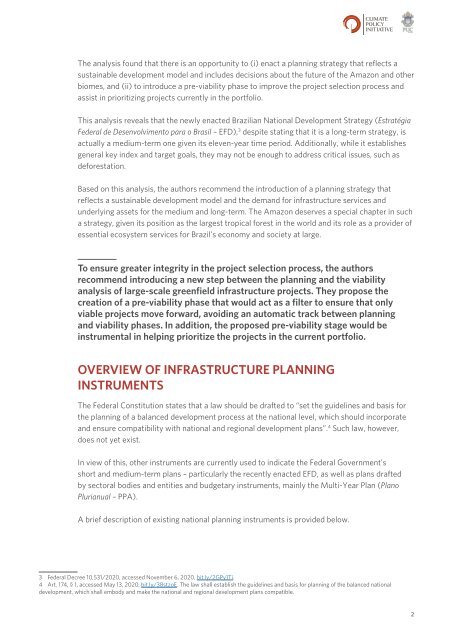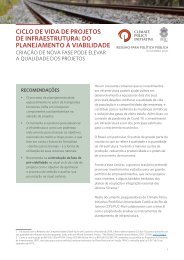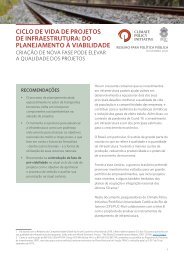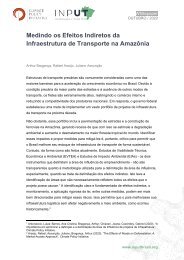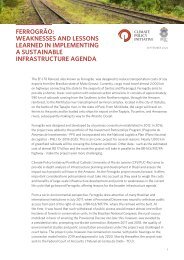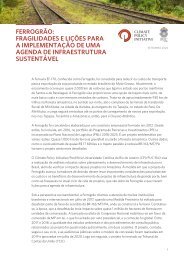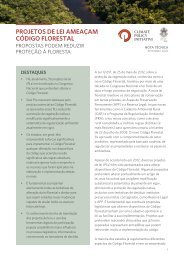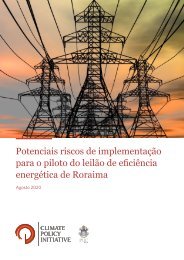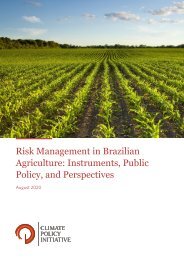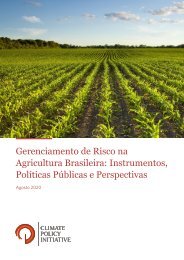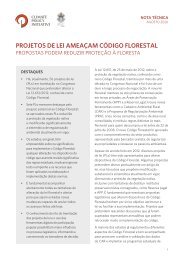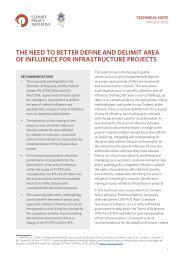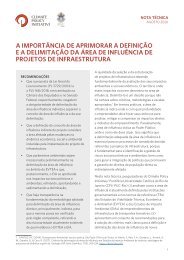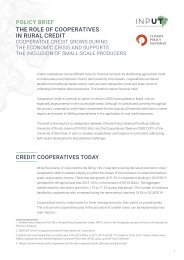Brazil’s Infrastructure Project Life Cycles: from Planning to Viability. Creation of a New Phase May Increase Project Quality
You also want an ePaper? Increase the reach of your titles
YUMPU automatically turns print PDFs into web optimized ePapers that Google loves.
The analysis found that there is an opportunity <strong>to</strong> (i) enact a planning strategy that reflects a<br />
sustainable development model and includes decisions about the future <strong>of</strong> the Amazon and other<br />
biomes, and (ii) <strong>to</strong> introduce a pre-viability phase <strong>to</strong> improve the project selection process and<br />
assist in prioritizing projects currently in the portfolio.<br />
This analysis reveals that the newly enacted Brazilian National Development Strategy (Estratégia<br />
Federal de Desenvolvimen<strong>to</strong> para o Brasil – EFD), 3 despite stating that it is a long-term strategy, is<br />
actually a medium-term one given its eleven-year time period. Additionally, while it establishes<br />
general key index and target goals, they may not be enough <strong>to</strong> address critical issues, such as<br />
deforestation.<br />
Based on this analysis, the authors recommend the introduction <strong>of</strong> a planning strategy that<br />
reflects a sustainable development model and the demand for infrastructure services and<br />
underlying assets for the medium and long-term. The Amazon deserves a special chapter in such<br />
a strategy, given its position as the largest tropical forest in the world and its role as a provider <strong>of</strong><br />
essential ecosystem services for <strong>Brazil’s</strong> economy and society at large.<br />
To ensure greater integrity in the project selection process, the authors<br />
recommend introducing a new step between the planning and the viability<br />
analysis <strong>of</strong> large-scale greenfield infrastructure projects. They propose the<br />
creation <strong>of</strong> a pre-viability phase that would act as a filter <strong>to</strong> ensure that only<br />
viable projects move forward, avoiding an au<strong>to</strong>matic track between planning<br />
and viability phases. In addition, the proposed pre-viability stage would be<br />
instrumental in helping prioritize the projects in the current portfolio.<br />
OVERVIEW OF INFRASTRUCTURE PLANNING<br />
INSTRUMENTS<br />
The Federal Constitution states that a law should be drafted <strong>to</strong> “set the guidelines and basis for<br />
the planning <strong>of</strong> a balanced development process at the national level, which should incorporate<br />
and ensure compatibility with national and regional development plans”. 4 Such law, however,<br />
does not yet exist.<br />
In view <strong>of</strong> this, other instruments are currently used <strong>to</strong> indicate the Federal Government’s<br />
short and medium-term plans – particularly the recently enacted EFD, as well as plans drafted<br />
by sec<strong>to</strong>ral bodies and entities and budgetary instruments, mainly the Multi-Year Plan (Plano<br />
Plurianual – PPA).<br />
A brief description <strong>of</strong> existing national planning instruments is provided below.<br />
3 Federal Decree 10,531/2020, accessed November 6, 2020, bit.ly/2GPy1Ti.<br />
4 Art. 174, § 1, accessed <strong>May</strong> 13, 2020, bit.ly/38stzoE. The law shall establish the guidelines and basis for planning <strong>of</strong> the balanced national<br />
development, which shall embody and make the national and regional development plans compatible.<br />
2


